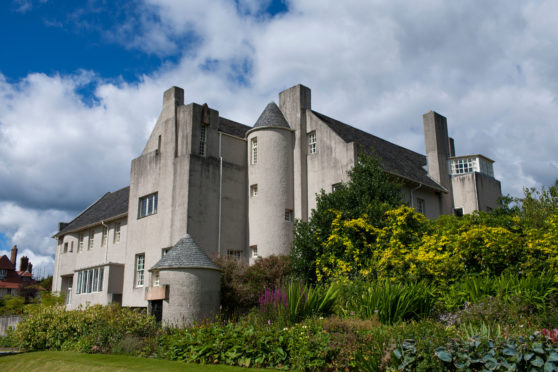
An old marvel that has become one of Scotland’s most unusual tourist attractions is welcoming its first visitors this weekend.
The Hill House in Helensburgh, considered the finest example of domestic architecture by Charles Rennie Mackintosh, has been put inside what is in effect a giant bubble.
The Box, as it is called, is a massive protective frame, encased in chain mail, inside of which the public can wander on elevated walkways, even past the chimney pots. The interior of the building will also be open to the public, who will follow in the footsteps of Hollywood star Brad Pitt, who visited the house when he was filming in Scotland.
The National Trust’s Emma Sweeney says the property’s weather-beaten woes go back to the very earliest days.
“We came across anecdotes from the family of the house leaking from the start and maids would put out buckets to catch the water,” said Emma.
“Mackintosh used an innovative material at the time, Portland cement, instead of lime harling on top of the sandstone. He didn’t realise it would crack and let water into the porous sandstone.”
The land for The Hill House was acquired by publisher Walter Blackie in 1902. At the time the Glasgow School of Art was nearing completion and Blackie “watched with interest its growth into the imposing structure that emerged”.
Although impressed by Mackintosh’s plans, the design incorporated the vision of Blackie.
He later recalled: “I told him that I disliked red-tiled roofs in the West of Scotland with its frequent murky sky; did not want to have a construction of brick and plaster and wooden beams; that, on the whole, I rather fancied grey roughcast for the walls, and slate for the roof.”
The total cost, including the furnishings and the garden, was just over £9,500 and it was ready by early 1904. Along with Walter and wife Anna were their five children, Jean, Alison, Ruth, Walter and Agnes.
Ruth remembered their being; “two housemaids, one cook and one table maid who did everything to do with the table and pantry”.
Although the house had the grandeur of being created by one of the world’s most famous architects, Emma says that first and foremost it was a family home for the Blackies.
There are even tales of one of Mackintosh’s distinctive chairs being broken by the children messing about.
“Mackintosh designed every room with a purpose for the family, making it all really practical.
“They enjoyed the house and they had their own things in all of the rooms. People see it now without family belongings but our accounts show it was absolutely stuffed with things.
“The children played there and there was a stereoscope – which makes two cards seem to merge into a 3D image – in one of the rooms for the children.
“We are getting one so that children today can experience how children amused themselves.”
The children also played in the extensive garden with the sweeping panoramas from its elevated position.
Emma spoke with granddaughter Ruth Currie who has come back to the house many times since the family moved away.
“She had loads of memories from childhood visits, including how she used to walk round the grid lines of the carpet in the hall,” said Emma. “She remembers her grandfather being in the library, where he used to write a lot of letters.”
The building has been put at risk through water being absorbed during a century and more of wet Scottish weather with around 190 days of rain annually.
The Box is the world’s largest chain mail structure, with 32.4 million rings weighing 8.3 tonnes.
It will keep the bad weather at bay while allowing the house to dry out for further conservation work to take place.
The total cost of saving The Hill House will be in the region of £4.5 million.

Enjoy the convenience of having The Sunday Post delivered as a digital ePaper straight to your smartphone, tablet or computer.
Subscribe for only £5.49 a month and enjoy all the benefits of the printed paper as a digital replica.
Subscribe